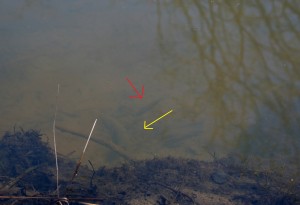Stickleback do not make nests in sand-filled plastic dishes!
Live, wild, behavior-doing stickles!
We stopped at Rabbit Slough (an anadromous population we keep “stocked” in the lab), just to take a quick look, and there they were! John spotted them in a flash. My first thought was these fish are huge and make our lab fish look puny.
I have read paper after paper about these little fish and I have seen some of their moves in the lab, but the imagination only goes so far, and the four walls of an aquarium are restrictive to the complexity of interactions that occur. Within a couple of minutes of John pointing out a nested male, we saw very interested gravid females jumping on the male, dorsal pricking, the male showing his nest

(to the ladies and to us!), fanning at the nest entrance and a courtship being broken up when a group of stickles came swimming by. We watched as an unwanted visitor was escorted from the premises and saw an Alaska blackfish swim through.
All of this greatness while crouched on a shoreline! What is amazing (and a bit unfortunate) is that a year ago I probably would have overlooked the rich interactions of these little fish and been entirely focused on the northern waterthrush in the tree next to the shoreline and the wilson’s warbler bouncing around the shrub down the way. It is fun to think that I am adding a new taxon of organisms to notice out in the field.
In the lab, we set up such controlled studies where we focus in on portions of the larger behavioral picture (and males set up nests in sand-filled plastic dishes). It was really brilliant to get to finally see how all of the pieces come together. I know that is what we came here to do – find/catch/observe stickles, and it may seem silly that I am so impressed by it all, but I can’t help it. I am impatiently awaiting the chance to jump in a lake and really get to observe.